Back in Atlanta 2011 when my favorite Borders Bookstore in Lenox Square was going out of business, all travel guides were 75% off. There was one travel guide left on the Sale shelf to a country I had not yet visited, Bradt’s Ethiopia. So I bought it. As a long time collector of travel guides, it was just one more to add to my bookshelf full of Lonely Planet guides, Let’s Go, Rick Steves, Moon Guides, etc. dating all the way back to Europe on $15 a Day. My travel guides were one of the toughest things I had to liquidate when I sold my home and went full time in the Winnie.
Leafing through that Ethiopia guide, reading about the eleven rock-hewn churches, I was struck with fascination over how they chiseled down into rock to a depth of up a 2 to 3 story building, then hollowed out the inside. They built each church from the top down, and then from bottom up. Nowhere else in the world has construction been done from the top down. It was a marvel! I knew that I wanted to see them one day, ergo my main reason for wanting to visit Ethiopia.
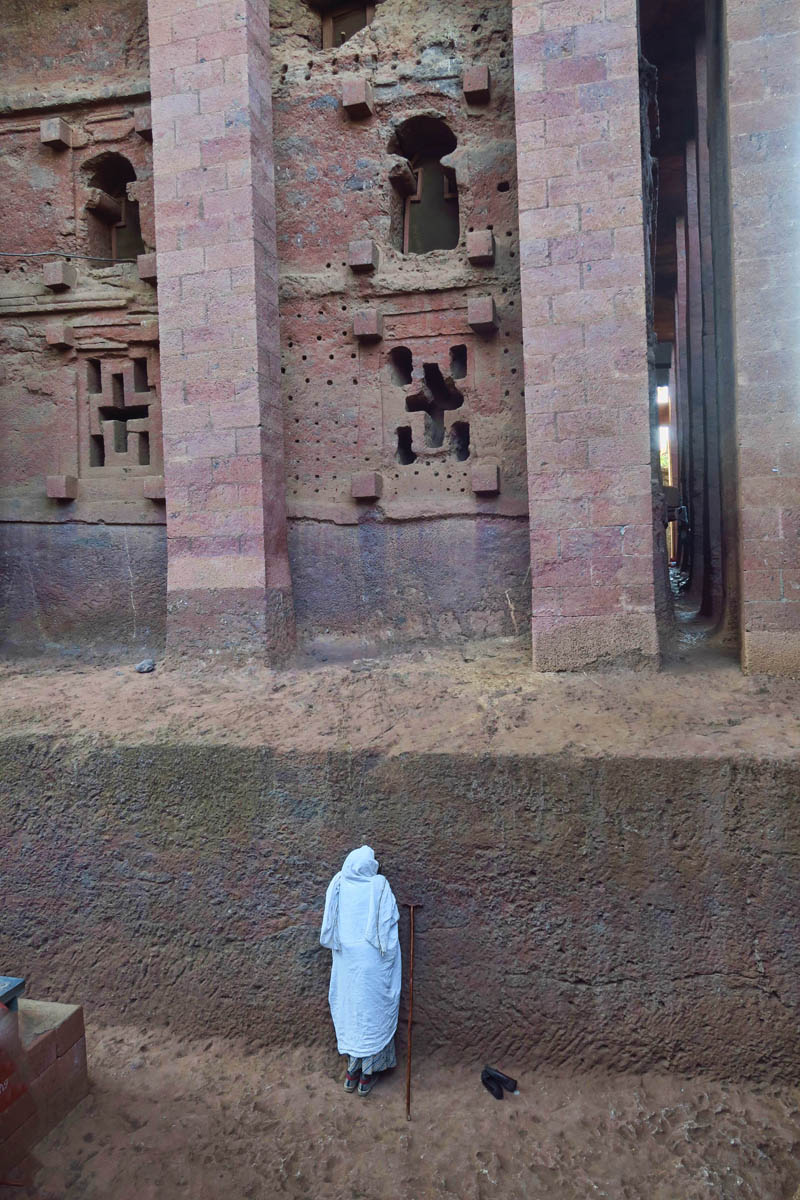
Lalibela’s churches are not only a historic monument, but they are still a place of worship with services every morning. The devout often kiss the walls, or pray with their forehead pressed against the stone.
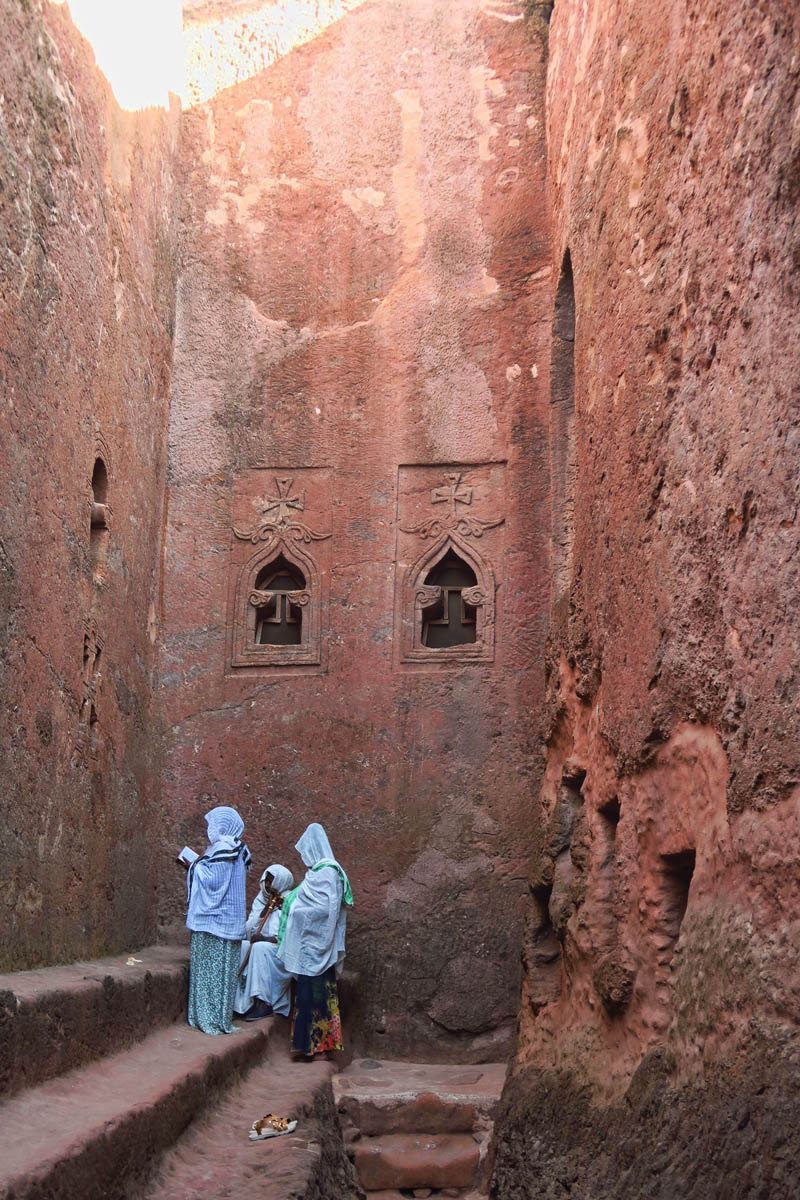
Lalibela is an important pilgrimage site where devout Christians visit Ethiopia’s version of “The Holy Land.”

Priests and pilgrims alike go about their worship in spite of the tourists walking through.

The best time to observe this is very early while the pilgrims and priests outnumber the tour groups.
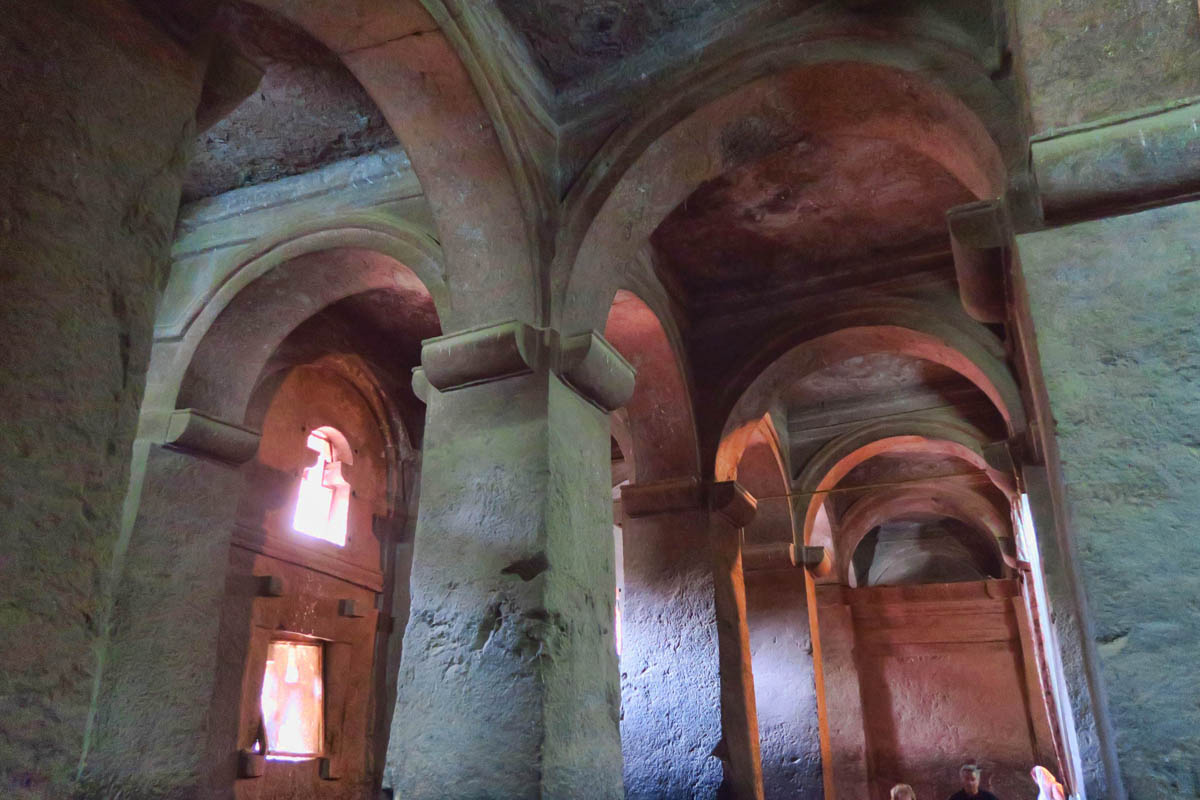
To contemplate how they went about hollowing out the insides, to have all the angles and arches meet is a real marvel.
Like all Ethiopian history, the story of Lalibela is laced with legends, fantasy, and folklore. As the story goes, King Lalibela, emperor of Ethiopia during the late 12th and early 13th Centuries, built these eleven churches (thirteen if you count the two “twin” churches with side by side altars.) 900 years ago. Legend has it they were built in only a year by men during the day, with the help of angels at night. Historians say it likely took around 23 years (where they came up with that number, I have no idea.) Other theories credit the Knights Templar, the Christian crusaders, with having built them. Fact is, no one really knows when they were built, or why.
The most logical explanation is that Ethiopian Christians had long engaged in pilgrimages across the Red Sea to the Holy Land. After all, even their Queen of Sheba had traveled there to meet King Solomon. However, following the capture of Jerusalem in 1187 by the Muslim leader Saladin, it was considered too dangerous for Christians to make this pilgrimage. So King Lalibela ordered his own “New Jerusalem” to be built right here in Lovely Lalibela. He even built a rock-cut river and named it the “River Jordan.”

This is “Bete Maryam” or the House of Mary, believed to be the first rock-hewn church in the complex. You might notice what looks like a swastika in one of the windows of this church. The symbol representing life and eternity was considered sacred for thousands of years before it became a symbol of hatred.
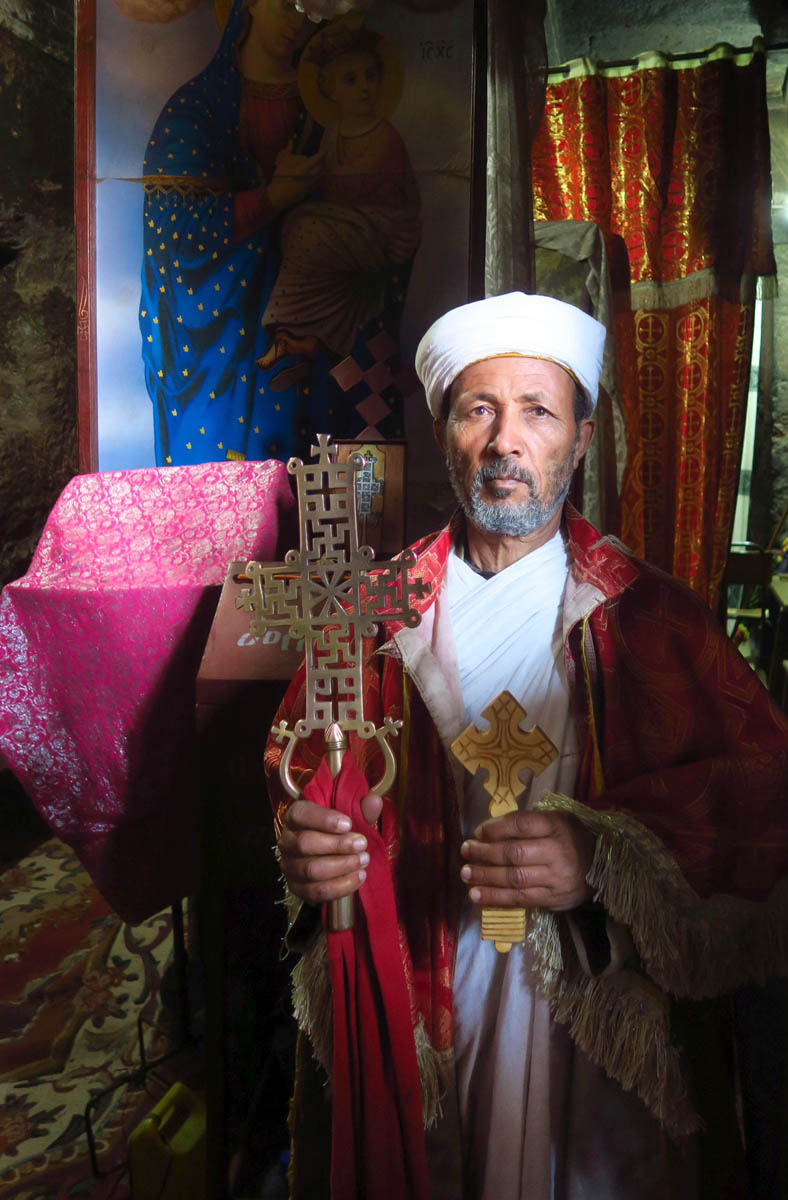
The priest is holding two different kinds of crosses. the one on the left is a processional cross mounted on a staff for ceremonies, while the smaller one on the right is used for a hand-held blessing during benedictions.

Some of the ceiling art is still visible. Hard to tell in this photo, but this is Joseph leading a donkey carrying Mary and the baby Jesus.

The ceilings in the House of Mary are quite elaborate, which is not always the case in some of the other churches. There is also an upper level with overlooking windows.
Lalibela is located in the Ethiopian central highlands at an elevation of 8,200 ft. As towns in Ethiopia go, it is one of the loveliest. We would be staying at the Panaorama Hotel, offering views from our balcony out over the mountains and valley below for three nights, a real luxury after our fast moving tour through the Danakil.
Lalibela is considered one of Ethiopia’s holiest cities, second only to Axum, “location of the Ark of the Covenant.” Unlike Axum which has a mix of religions, the population of Lalibela is almost completely Ethiopian Orthodox Christian. It served as the capital of Ethiopia in the 12th and 13th centuries before the capital was relocated to Addis Ababa.

A typical house found only in Lalibela; round, two story, with a conical roof.

We took a break in between exploring the north and south complexes, and visited the big Saturday Market, where shade comes at a premium.
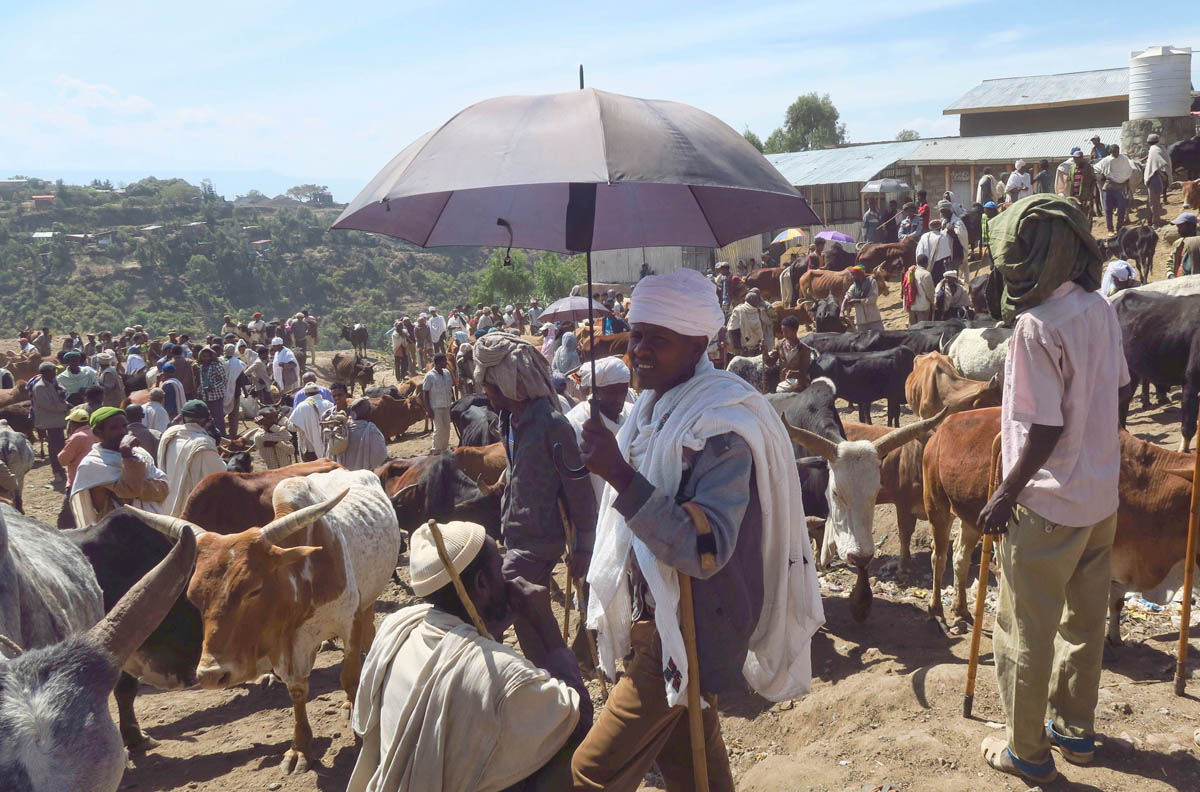
Umbrellas, both functional and decorative, are very popular throughout Ethiopia.
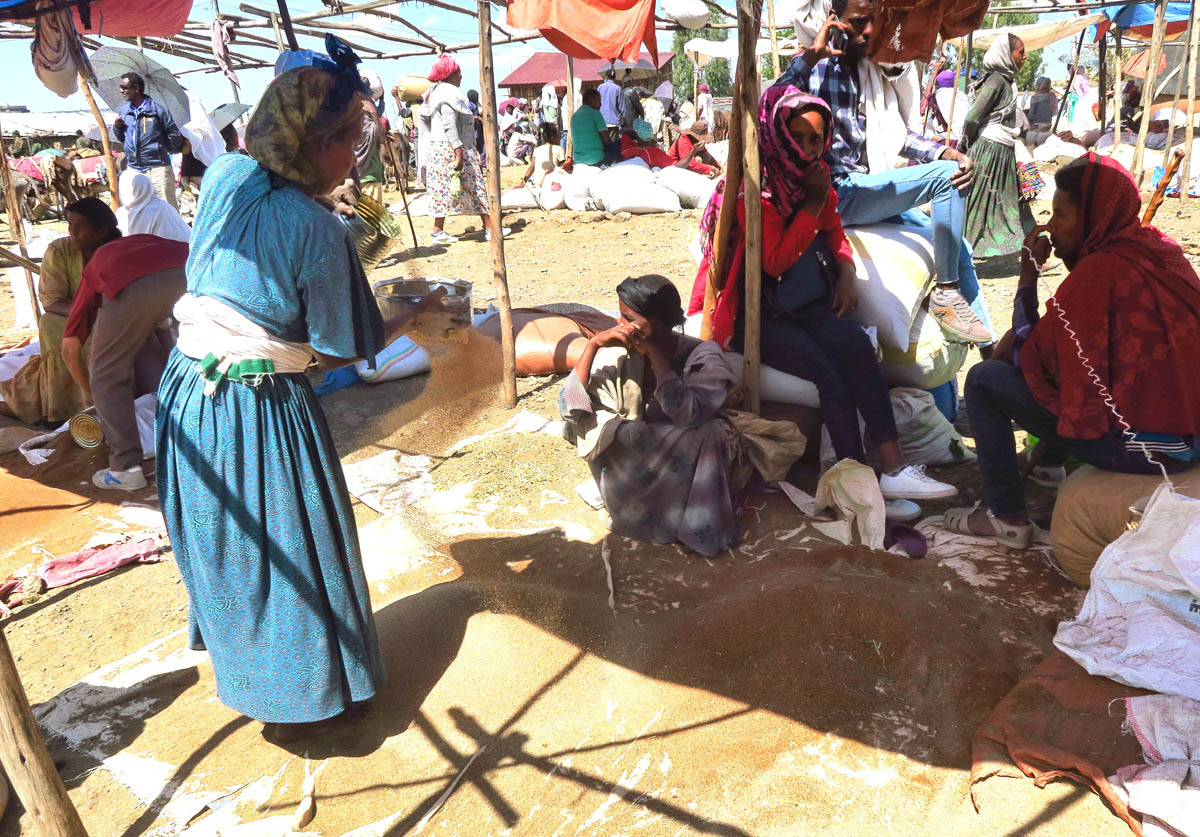
Hard to tell from this photo, but this woman is sifting “teff,” which is the grain used to make the fermented pancake, injera.


Salt for sale…maybe from the Danakil?
We would have a full day tour with a guide to explore the two church complexes, as they are divided into two clusters, north and south. During this tour, we would visit all eleven of the churches, which are comprised of three types; the monolith, which is free standing on all four sides, the semi-monolith, which is still attached by one wall to the cliff-side, and the cave churches. While all eleven of Lalibela’s churches are classified as “monolithic” (cut from a single stone,) our guide tells us that only six are actually free standing on all four sides, with four being semi-monolithic, and one being considered a cave church.
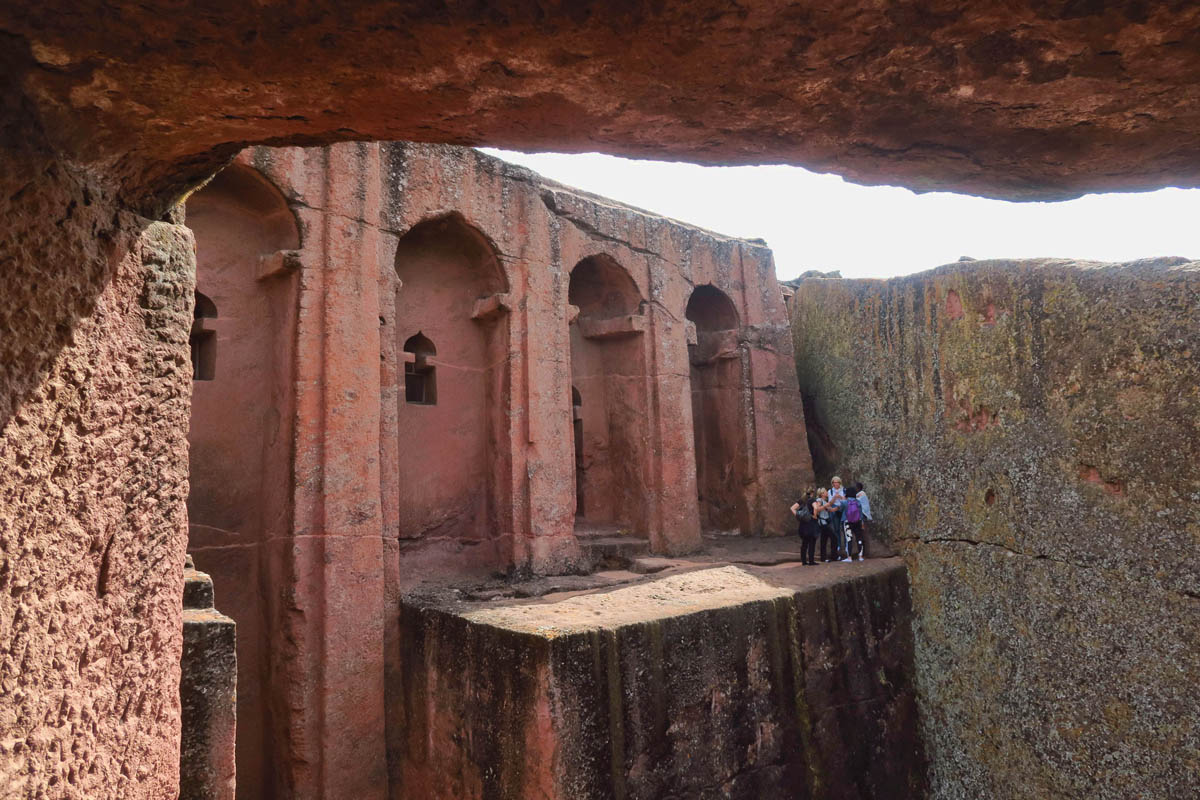
In the afternoon, we visit the south cluster. This building was first believed to be yet another church, however the atypical flat ceilings as well as this large terrace has led historians to believe this started out as a palace or royal residence.
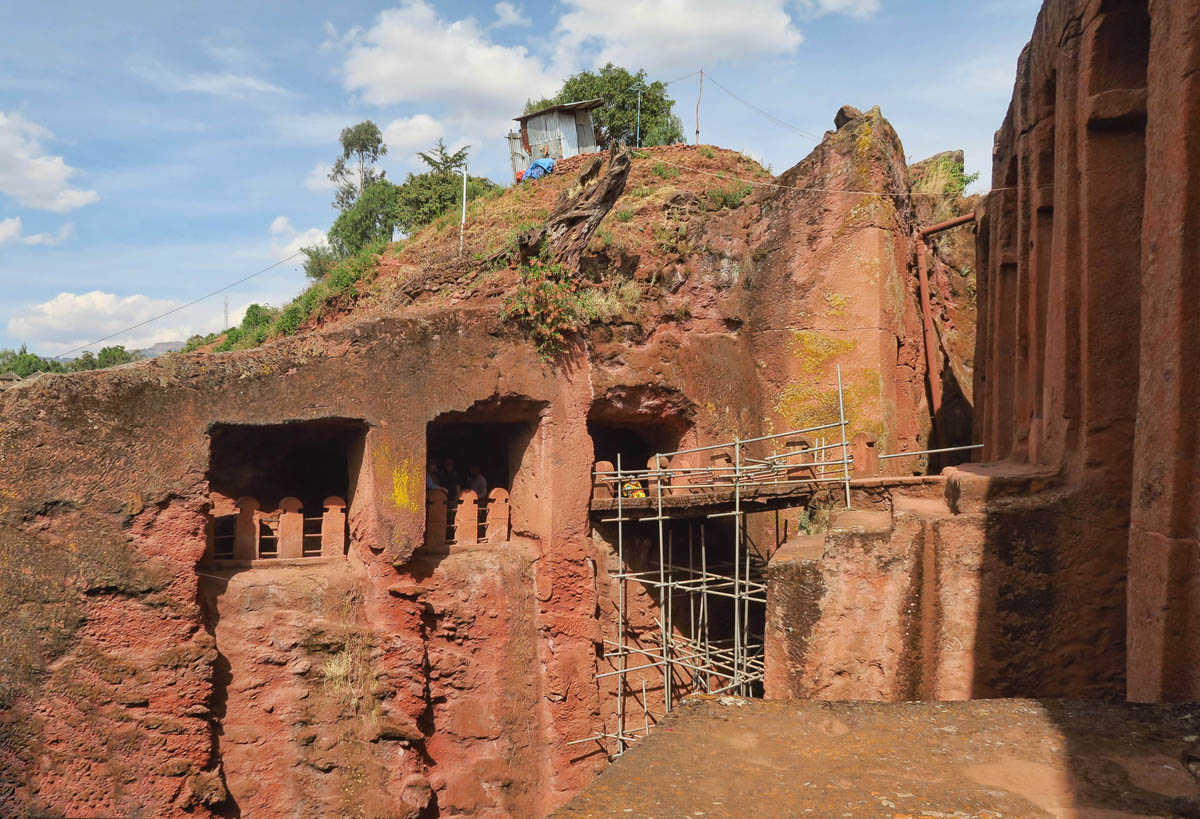
View from the terrace looking back across at the adjacent building. Deep-cut trench in between might have served as a moat.

The Three Wise Men appear often in the church paintings. One of the three, Balthazar is considered a native son, as legend places his tomb in Axum.
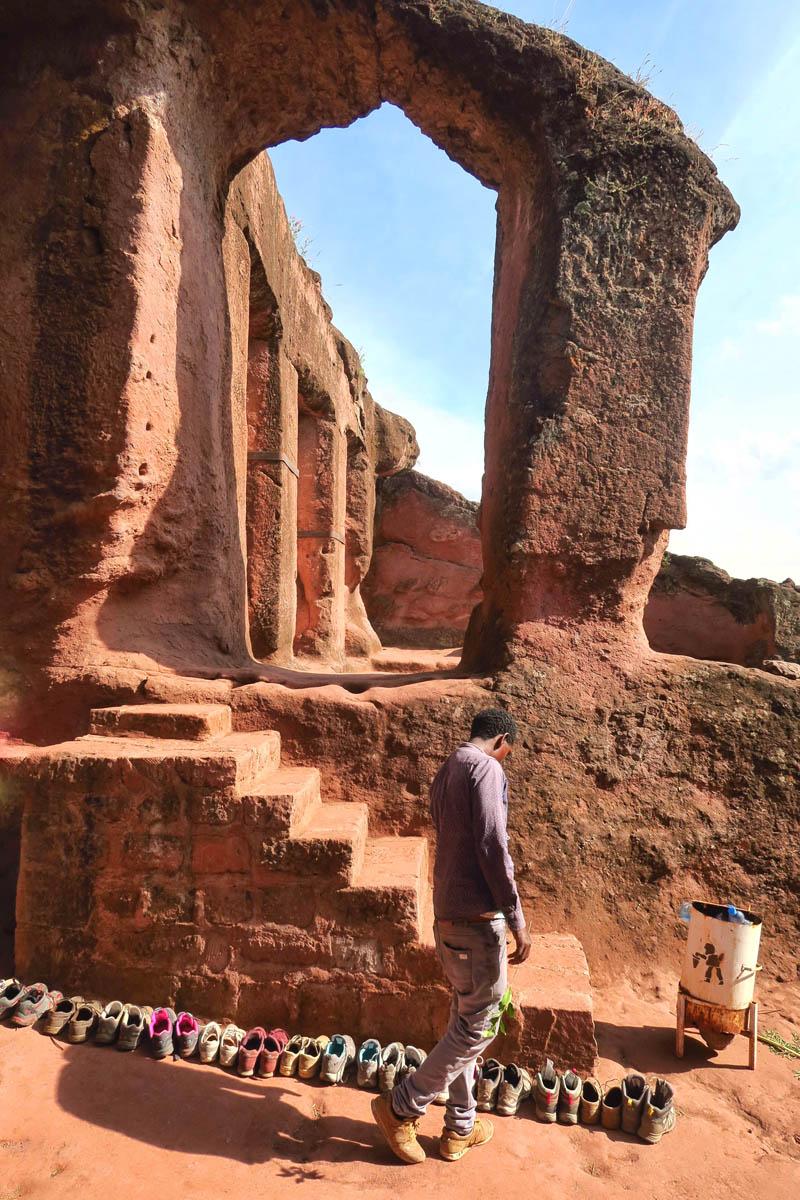
Most tour groups hire a “shoe minder,” as shoes must be removed to enter the churches. Not only do they prevent theft, but they also tend to the shoes. Our “shoe man” was so good, he was like valet service, remembering which shoes belonged to whom. He was studying to be a guide.
We would explore the northern cluster first, which contained both what is believed to be the largest monolithic church in the world standing at 33 feet, complete with it’s own courtyard, Bete Medhane Alem, (House of the Savior of the World,) Bete Golgotha Mikael (House of Golgotha Mikael) believed to contain the tomb of King Lalibela, and Bete Maryam (Church of Virgin Mary,) the first church believed to be excavated.
Many of the churches are connected by a series of tunnels and trenches cut into the rock. Our guide asks about claustrophobia, as we will need to walk through one tunnel with one hand on the wall to find our way, and the other hand on the ceiling to avoid hitting our heads. At one point, it is so dark that I depend on the voices of my travel mates to know if I am falling behind.

Four of the churches have now had awning structures placed over them by UNESCO to protect them from further erosion.
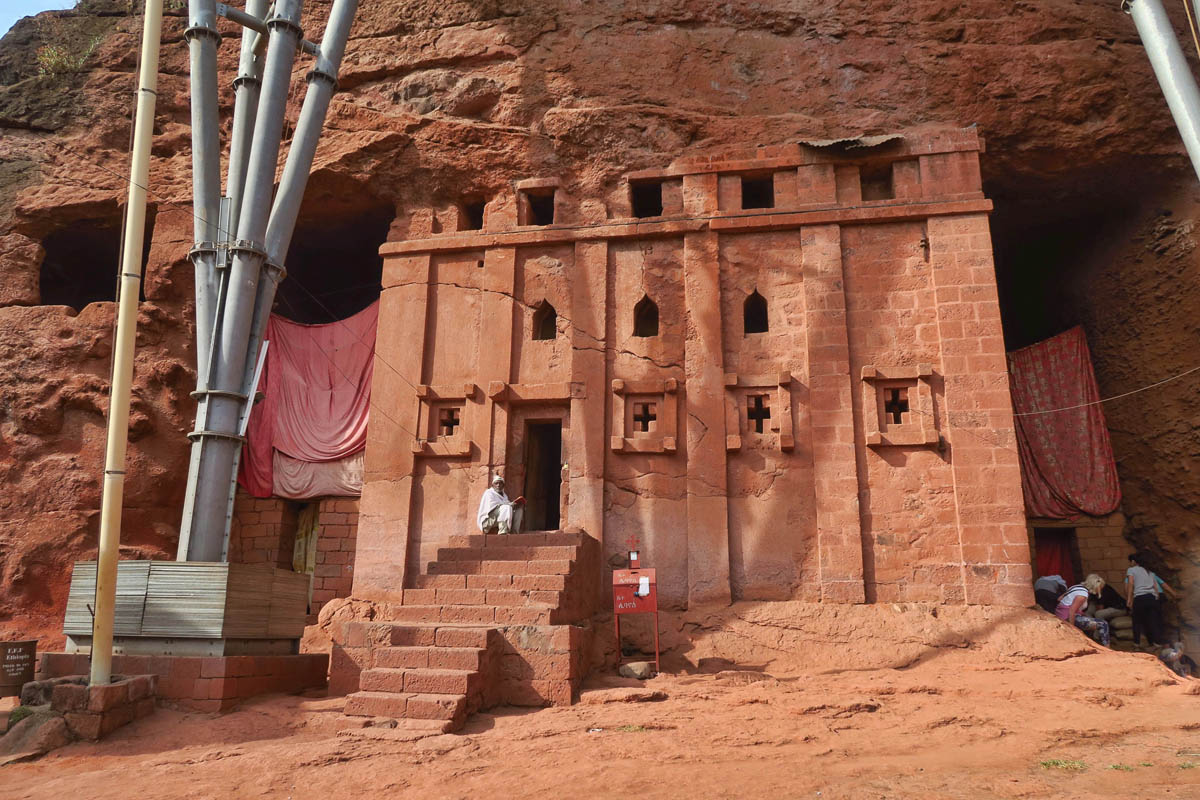
Notice on the left the massive pole structure to hold the awning overhead. They have been quite controversial, as many say they are unsightly and detract from the aesthetics of the churches. But drainage is a problem. On the right side, you will see some bricks from restoration, as many of the drainage ditches originally built have been filled with earth causing erosion to accelerate.

I can’t imagine how you would begin to carve a barrel-vaulted ceiling out of rock.

The photogenic priests are as much a part of the churches as the arches, altars, and artwork.
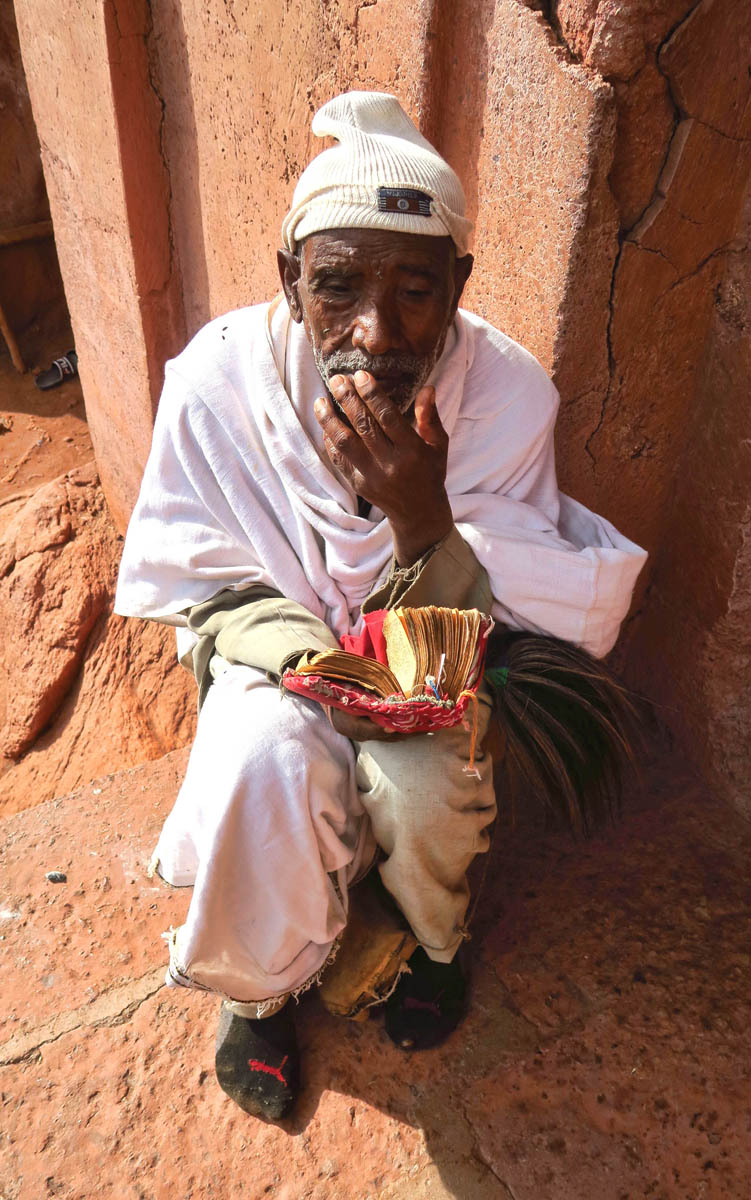
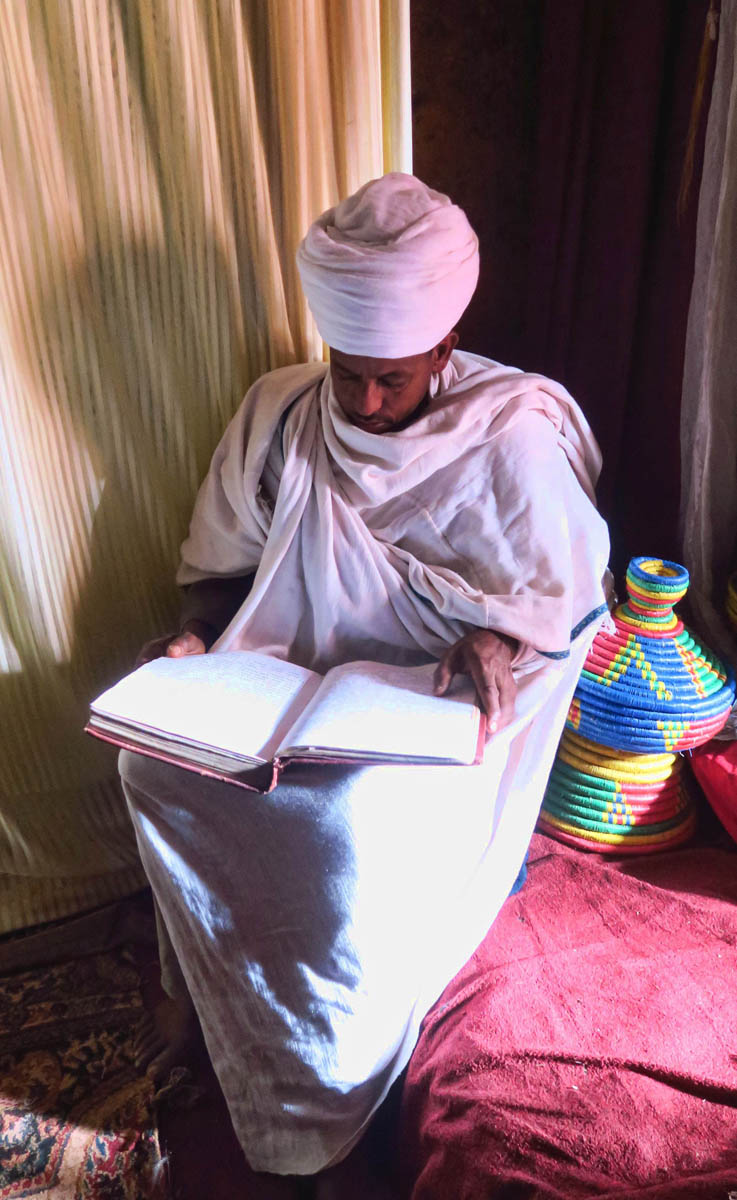
The southern cluster contains five churches, however they are not as consistent in design as the northern cluster churches. Rather than the arched ceilings with cross-shaped windows, they have flat ceilings, leading some historians to believe they were not originally churches, but rather palaces or royal residences, possibly even pre-dating King Lalibela.
But the one church I had most wanted to see, the most iconic image of the Lalibela church complex and possibly Ethiopia itself, and the image I had seen in that Bradt Guide to Ethiopia some nine years ago that inspired me to visit, Bete Ghiorgis (House of St. George,) stands alone in isolation. Forming a triangle with the north and south complex, it stands about 1,000 ft away, connected by a series of drainage ditches and passageways. However, the best way to approach the House of St George is from the hill above, so one can get a complete overview from the surrounding area to see how the structure was built in the form of a cross.

Finally, the moment I had been waiting for, we come upon the most iconic of all the Lalibela churches, Bete Giyorgis, or the Church of Saint George. It’s the only church carved in the shape of a cross.
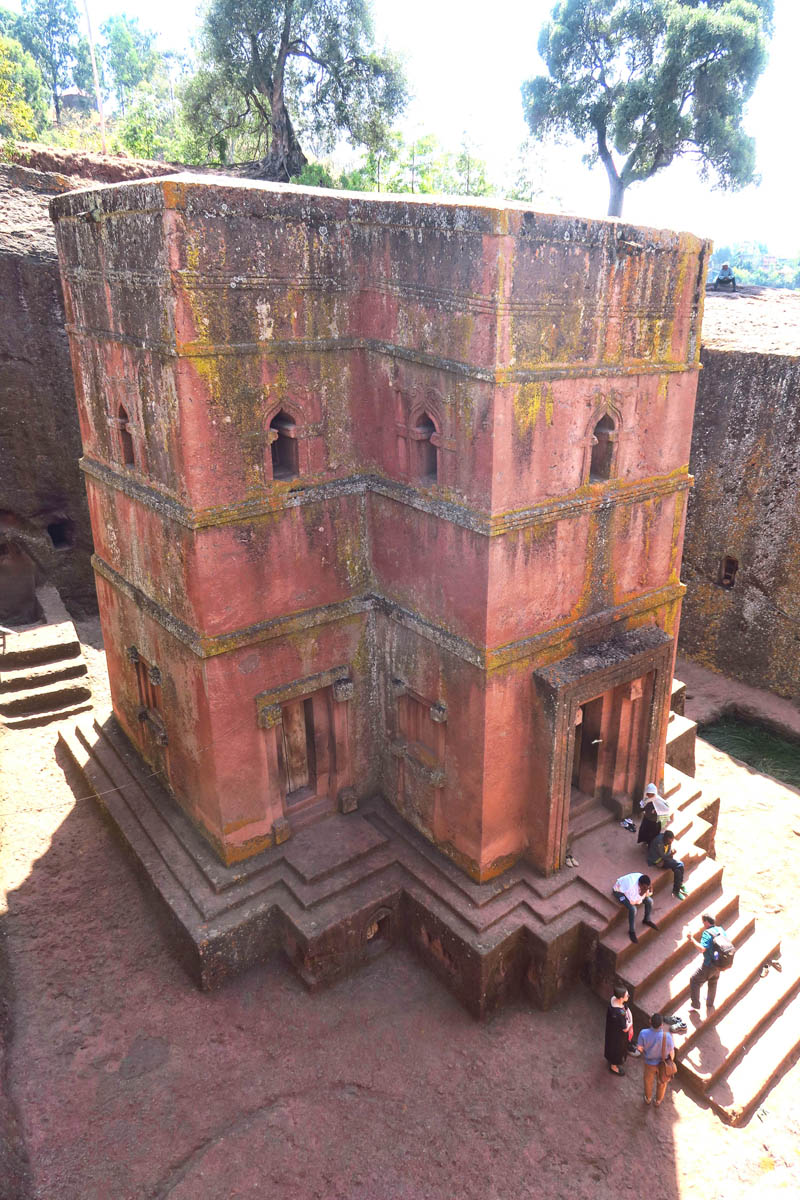
(From Wikipedia) “On first approach the site appears wholly inaccessible, with sheer drops on every side and no access bridge. It is accessed via a very narrow man-made canyon, spiraling downwards, which changes to a tunnel close to the church to further conceal its presence.”

Water that has flowed down from the top of the church is believed to be Holy Water.
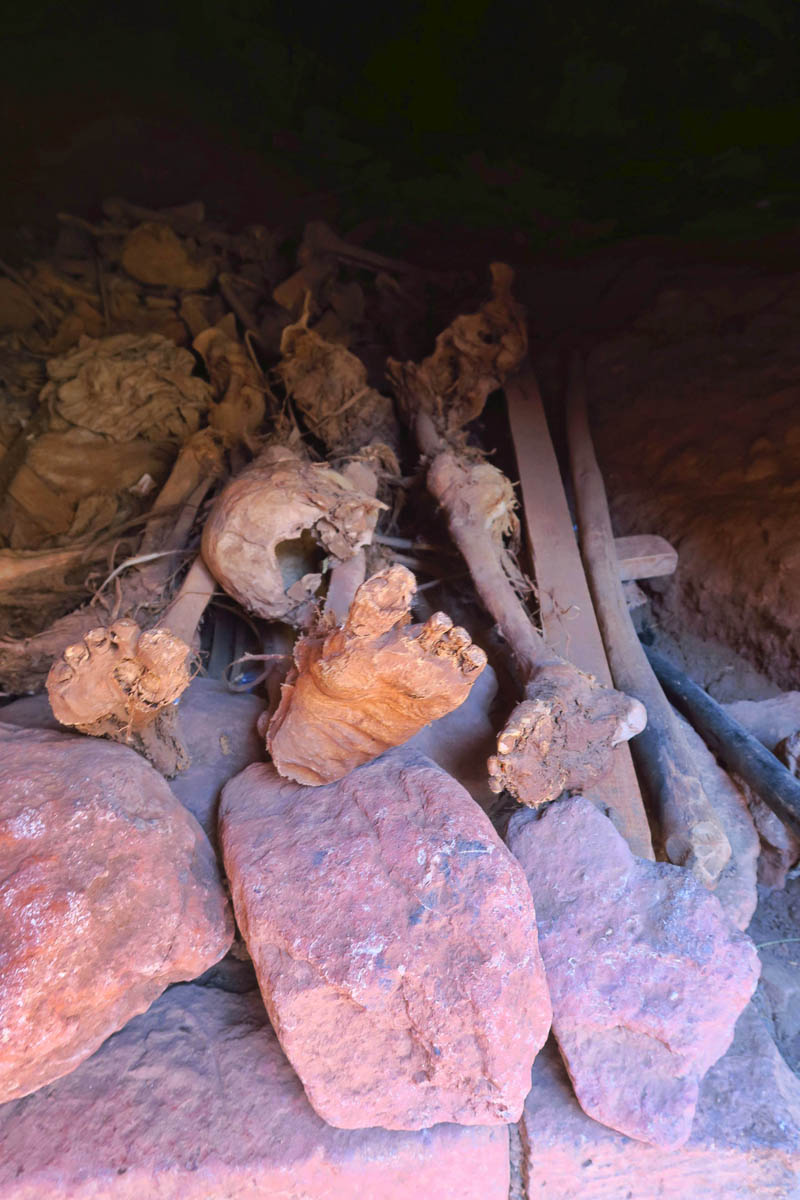
Pilgrims that died after reaching the site are buried in a small, open tomb.
The church complex of Lalibela was just as impressive as I had anticipated. As I have said in the past, I am not a religious person, but I am inspired and amazed at those who go to such great lengths to demonstrate their faith.
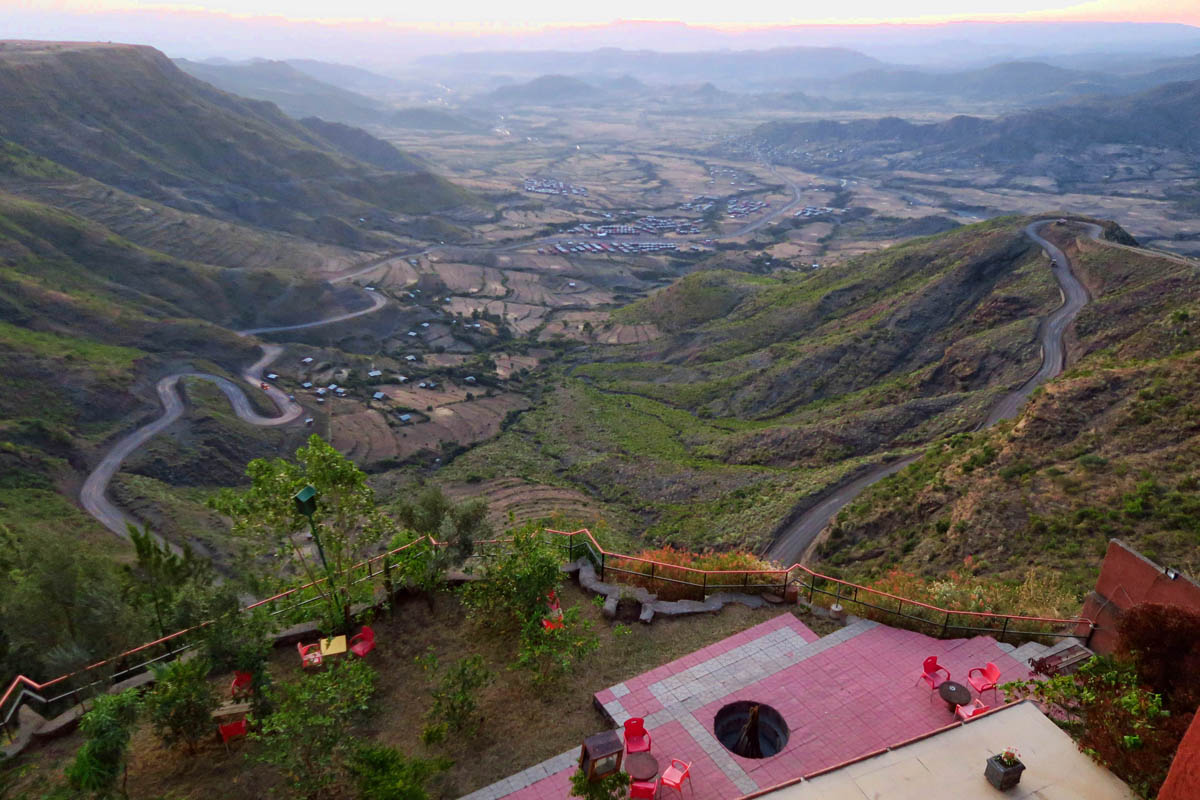
The lovely view from our balcony in the Panoramic Hotel.

We happen upon yet another festival on our second day in Lalibela.

Timkat is past, so I am not sure what this one was about. We are told it is a celebration to do with Saint George. There is lots of drumming on animal skin drums and chanting.

The procession starts at the Church of Saint George, and progresses through the streets.

The two guys in the middle with the large flat fringed planks on their heads are carrying the replica of the tablets, believed to be inside the Ark of the Covenant.

The procession walks on red carpet that is picked up and moved forward as they proceed. Carpet is laid down, women sweep it, and after the priests walk by, it is picked up and leap-frogged forward.
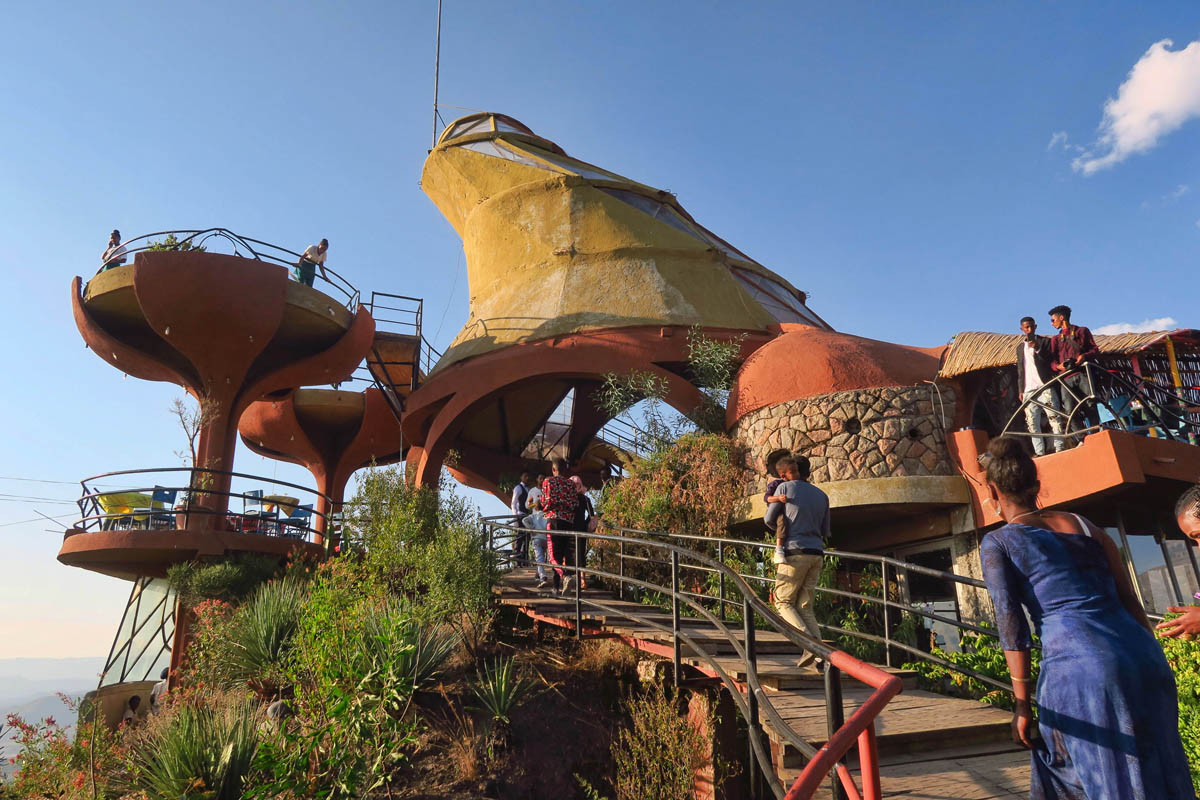
On our last night in Lalibela, we have a group dinner at a crazy restaurant called Ben Abeba, owned by an Ethiopian man and a Scottish woman, featuring specialties from each respective country.

This is a photo of Lynette’s “Fasting Injera.” Not me, I went for the Scottish Shepherd’s Pie.
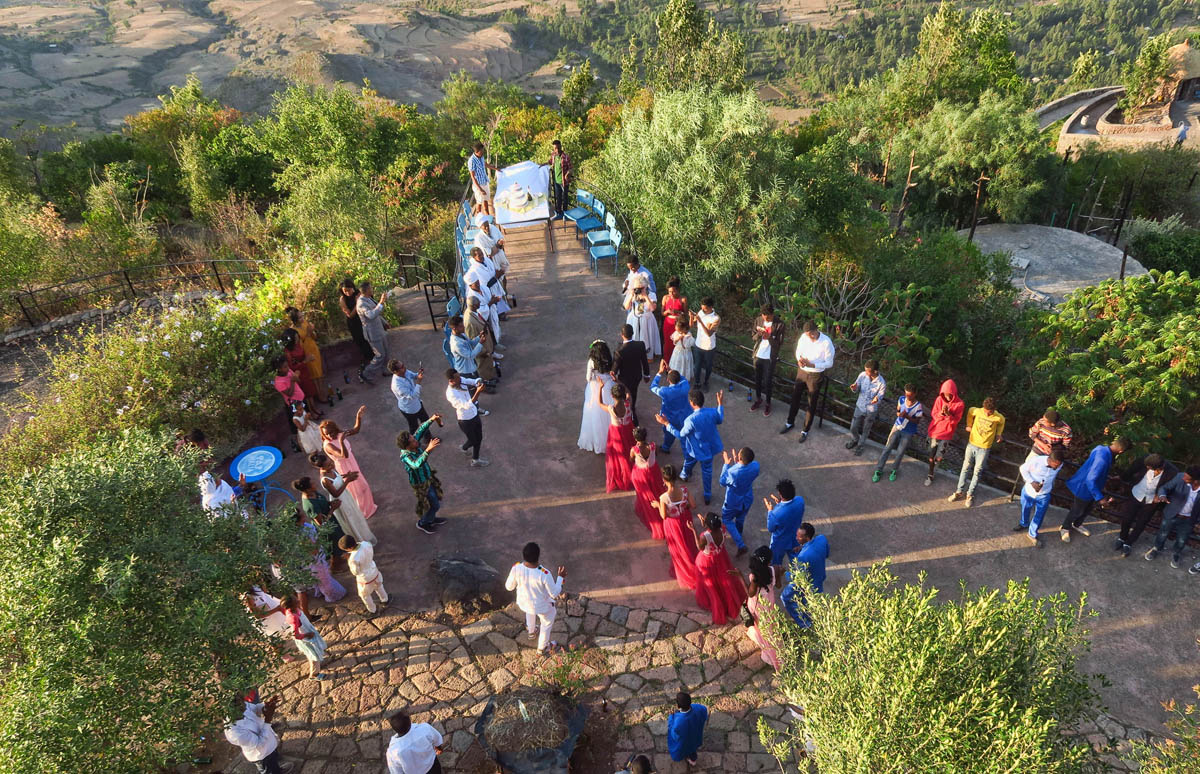
The restaurant is a well known place for weddings. There are two taking place while we dine.
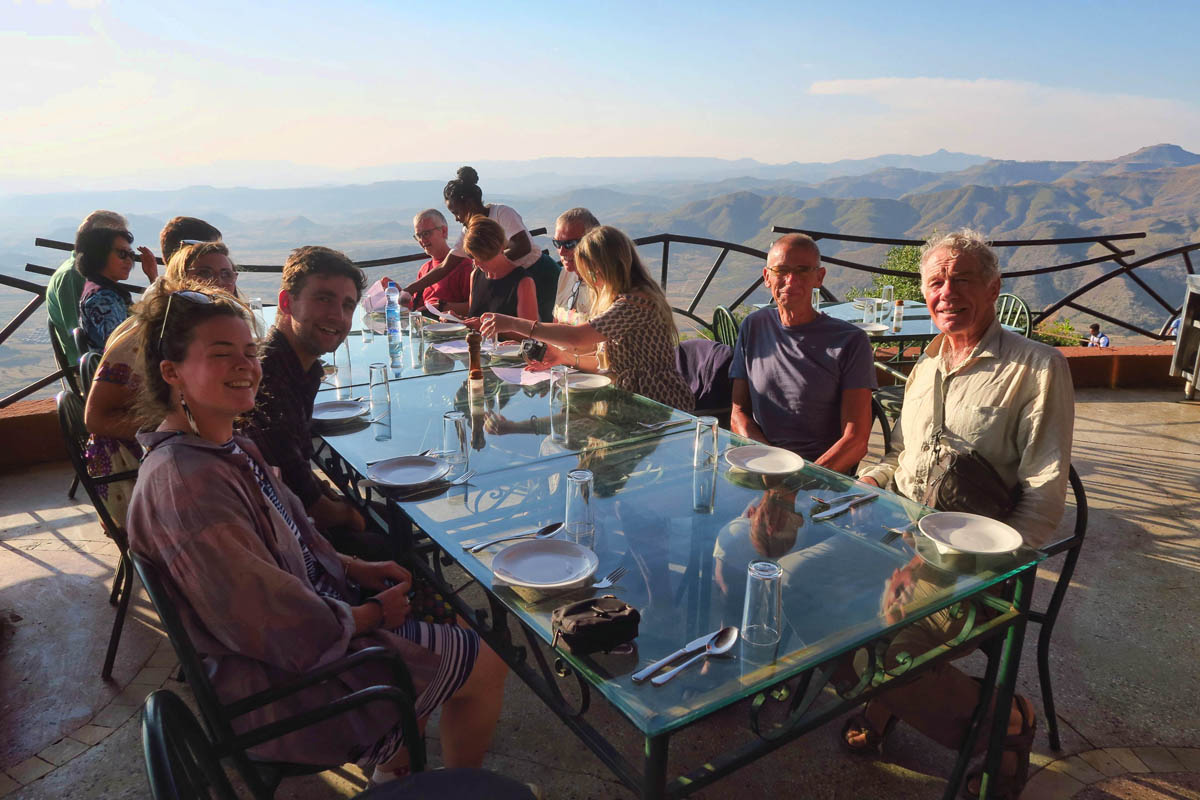
We have a table overlooking a gorgeous view of the sunset, a fitting farewell to the Lovely Lalibela, where even the name is beautiful.

Absolutely fascinating, Suzanne. I can’t imagine the effort that went into carving those churches out of solid rock. And the photographs are superb, especially the one of the priest holding the crosses, the seated priest reading his book, the priest sitting on the red carpet, and the injera plate. National Geographic quality. Thank you for sharing!
As Rick Steves says, “Keep on traveling.” And take us with you.
This post about Lalibela has me totally astonished, and the natives and their culture! in addition to the history is still there to observe and marvel. Loved the market and festive procession photos. And the lodging facility on top of the mountain with that view from the open terrace, totally magnificent!
When I read your first Ethiopian post I went to Goggle maps and saw Lalibela and discovered the churches which I had never heard of. I am delighted you went so I could see and learn so much more. Thank you for sharing these terrific marvels and your wonderful photos, especially of the priests.
I haven’t really traveled outside North America, but i thought i knew quite a bit about the rest of the world! Thank Goodness for your blog! i am learning so much about some of the amazing places! These churches are just off the charts! Do you have any idea what books, particularly the older one were reading?
What an amazing feat to create these churches from the top down. I was telling John about them and next thing I know he is reading about them and looking at photos online. The painted ceiling in the one is gorgeous. That is a spectacular view from your hotel (that you truly deserved). What a cool and unique restaurant. Thanks again for taking us along. I am so loving this journey and all the new things I am learning!
Wonderful! I am amazed that there is so much to see in a country most of us think is just a dry, starving desert.
Your photograph of the priest…the fringe, his expression, the sheen, the pink and red, the textured rug, the lighting…left me satiated.
There is nothing I can add to the comments above that would help you understand how your photographs and writings affect me. Your travels through these places of color and enchantment and beauty could not have been presented in a more meaningful way. Thank you for opening my eyes and deepening my knowledge of the magnificence of this far away land. I appreciate you so.
I am always amazed by the energy that humans put into religious edifices and the Ethiopians delight me with their creations. Absolutely impressive from ll aspects. Your trip has confounded us and delighted us with your pictures and prose. Once again we thank you.
allen
The churches are wonderful and engineering marvels. Thanks for sharing your trip and stunning photos.
That cross church is off the hook! 🙂 All of them are fascinating and humbling as I sit in my comfortable chair in my 74deg office. 🙂
And that restaurant! So cool. Love the photo of the goats huddled under the umbrella.
I do have a question (as usual) – are the walls & ceilings in the House of Mary tiled? Some kind of paint?
I always love your questions! I just don’t always know the answers. You should come along with me sometime so I know what to ask. 😉 I am pretty certain it was only paint, like a “fresco” where they mix the paint with plaster, but I am not sure about that. I only saw decorations like that in the one church, which also makes me wonder…
Absolutely FASCINATING! I am so glad you took so many photos and gave such amazing descriptions and history!